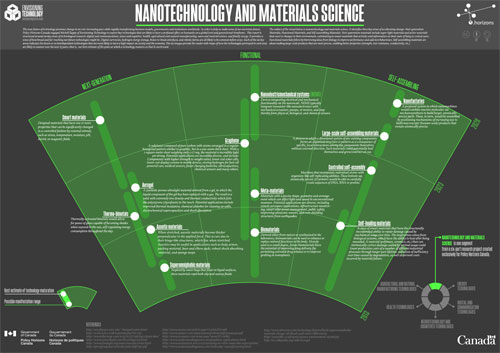Nanotechnology and Materials Science

PDF: Nanotechnology and Materials Science
On this page
Related Reports
Overview
What are you looking at
Next-Generation
Functional
Self-Assembling
References
Figure 1 : Nanotechnology and Materials Science

This diagram is 1 segment from a 6 part map on technology futures that offers a detailed look at potential technology advances in 6 key areas (digital and communications, neuro and cognitive, health, agriculture and natural manufacturing, nano and material science and energy) chosen for their likelihood for significant disruptive potential on work, life, firms and policy over the next 15 years. The visualization analyzes how nanotechnology and material science technologies are likely to manifest over the next 15 years. It identifies three key areas of accelerating change: Next Generation materials, Functional materials, and Self-assembly. In next generation materials, significant changes are expected as a result of advances in superomniphobic materials, auxetic materials, thermo bimetals, aerogel, and smart materials. In functional materials, changes are likely to come through bio and metamaterials, graphene, and nanoelectricmechanical systems (NEMS). Finally in self-assembling materials, big changes are likely in things like self-healing materials, controlled self-assembly, large-scale self-assembling materials, and nanofactories.
Related Reports
Energy Technologies
Digital and Communication Technologies
Neurotechnology and Cognitive Technologies
Health Technologies
Agricultural and Natural Manufacturing Technology
Overview
The near future of technology promises change at an ever-increasing pace while rapidly transforming business models, governments and institutions worldwide. In order to help us make sense of our uncertain future, Policy Horizons Canada engaged Michell Zappa of Envisioning Technology to explore key technologies that are likely to have a profound effect on humanity on a global level and generational timeframe. This report is structured around six key areas of technological research: digital and communications, neuro and cognitive, health, agricultural and natural manufacturing, nano and material science, and finally energy. It provides a sense of how broad and far-reaching our future technologies might be. Digital currencies, hydrogen energy storage, brain-to-brain interfaces, and robotic farms are all likely to be common before 2030. Each of the six key areas indicates the dozen or so interdependent technologies that are most likely to have a high impact on society and the economy. The six key areas provide the reader with sense of how the technologies portrayed in each area are likely to mature over the next 15 years; that is, our best estimate of the point at which a technology matures so that it can be used.
What are you looking at
Below are technologies related to nano and material science under three key areas of accelerating change: Next-generation materials, Functional materials, and Self-assembling materials. Next-generation materials include super-light materials and active materials that react to changes in their environment and ultimately smart materials that explain how they are doing. Functional materials follow by borrowing ideas from biology to improve performance and add new behaviours. Self-assembling materials are about making large-scale products that are more precise, enabling better properties (strength, tear resistance, conductivity, etc.).
Next-Generation
Superomniphobic materials: Inspired by water bugs that float on liquid surfaces, these materials repel both oily and watery fluids.
Auxetic materials: When stretched, auxetic materials become thicker perpendicular to the applied force. This occurs due to their hinge-like structures, which flex when stretched. Auxetics may be useful in applications such as body armor, packing material, knee and elbow pads, robust shock absorbing material, and sponge mops.
Aerogel: A synthetic porous ultralight material derived from a gel, in which the liquid component of the gel has been replaced with a gas. The result is a solid with extremely low density and thermal conductivity which feels like polystyrene (styrofoam) to the touch. Potential applications include improved thermal insulation, chemical absorber for cleaning up spills, electrochemical supercapacitors and shock absorption.
Thermo-bimetals: Thermally activated bimetals would allow for panes of glass capable of becoming shades when exposed to the sun, self-regulating energy consumption throughout the day.
Smart materials: Designed materials that have one or more properties that can be significantly changed in a controlled fashion by external stimuli, such as stress, temperature, moisture, pH, electric or magnetic fields.
Functional
Biomaterials: Derived either from nature or synthesized in the laboratory, biomaterials can be used to enhance or replace natural functions in the body. Already used to a small degree, future biomaterials have the potential of improving drug delivery (by permitting extended drug release) or to improve grafting in transplants.
Meta-materials: Materials with a precise shape, geometry and arrangement which can affect light and sound in unconventional manners. Potential applications are diverse, including remote aerospace applications, infrastructure monitoring, smart solar power management, public safety, improving ultrasonic sensors, and even shielding structures from earthquakes.
Graphene: A substance composed of pure carbon with atoms arranged in a regular hexagonal pattern similar to graphite, but in a one-atom thick sheet. With a 1-square-meter sheet weighing only 0.77 mg, the material is incredibly light yet strong. Potential applications are incredibly diverse, and include: Components with higher strength to weight ratios, lower cost solar cells, lower cost display screens in mobile devices, storing hydrogen for fuel cell powered cars, medical sensors, faster charging batteries, ultracapacitors, chemical sensors and many others.
Nanoelectricmechanical systems (NEMS): Devices integrating electrical and mechanical functionality on the nanoscale. NEMS typically integrate transistor-like nanoelectronics with mechanical actuators, pumps, or motors, and may thereby form physical, biological, and chemical sensors.
Self-Assembling
Self-healing materials: A class of smart materials that have the structurally incorporated ability to repair damage caused by mechanical usage over time. The inspiration comes from biological systems, which have the ability to heal after being wounded. A material (polymers, ceramics, etc.) that can intrinsically correct damage caused by normal usage could lower production costs of a number of different industrial processes through longer part lifetime, reduction of inefficiency over time caused by degradation, as well as prevent costs incurred by material failure.
Controlled self-assembly: Machines that manipulate individual atoms with organism-like self-replicating abilities. These bottom-up, atomically precise 3D printers would be able to carefully create sequences of DNA, RNA or protein.
Large-scale self-assembling materials: A process in which a disordered system of pre-existing components forms an organized structure or pattern as a consequence of specific, local interactions among the components themselves, without external direction. Such materials could potentially heal themselves and grow/contract on cue.
Nanofactories: A proposed system in which nanomachines would combine reactive molecules via mechanosynthesis to build larger, atomically precise parts. These, in turn, would be assembled by positioning mechanisms of increasing size to build macroscopic (human-scale) products that remain atomically precise.
References
http://uw.physics.wisc.edu/~himpsel/wires.html(link is external)
http://www.scin.co.uk/material.php?id=335(link is external)
http://www.theverge.com/2012/10/27/3562340/doris-kim/(link is external)
http://www.sensorland.com/HowPage023.html(link is external)
http://www.foresight.org/nano/nanofactories.html(link is external)
http://gmwgroup.harvard.edu/pubs/pdf/936.pdf(link is external)
http://www.azom.com/article.aspx?ArticleID=168(link is external)
http://www.nature.com/nmat/journal/v8/n6/pdf/nmat2451.pdf(link is external)
http://www.azonano.com/news.aspx?newsID=26867(link is external)
http://www.understandingnano.com/graphene-applications.html(link is external)
http://www.nextnature.net/2012/09/eating-in-vitro-meat-the-expectations/(link is external)
http://www.understandingnano.com/molecular-manufacturing.html(link is external)
http://www.bbc.co.uk/news/science-environment-15096393(link is external)









